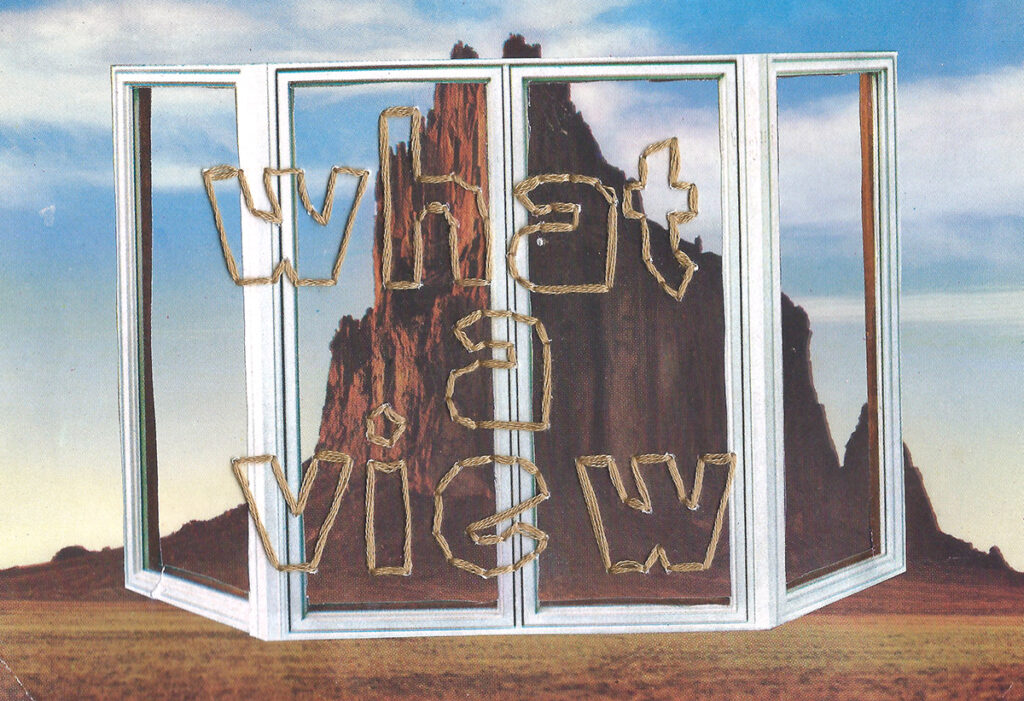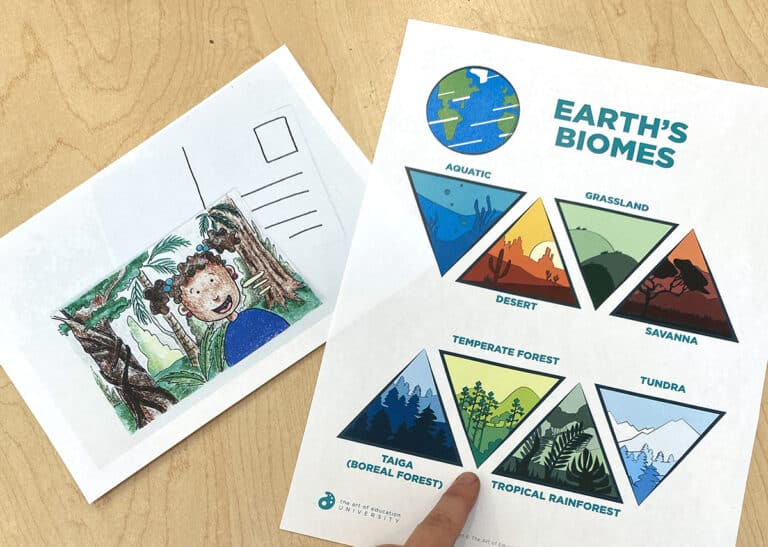Are you looking for a way to mix things up with your lessons or personal art practice? Try adding a layer of embroidery on a collage, painting, or drawing! Custom dye your own fibers or plan a fun shopping trip to purchase a specific color. Mix soft embroidery thread with different types of paper to create an exciting texture experience. Even the prep work of punching holes in your paper with a needle is super satisfying.
Keep reading to gain inspiration from contemporary artists, then learn six ways to apply embroidery techniques to bring artwork to the next level.

Let’s see how contemporary artists use embroidery thread and paper in unexpected and innovative ways.
Note: Be sure to review all resources and artists before determining if they are appropriate to share with your students.
Bring these artists into your classroom to inspire your students. Or peruse them for fresh ideas to apply to your own artwork.
- Lisa Kokin uses reclaimed paper, currency, book pages, leaves, and thread to create detailed pieces that are unified through symmetry, color, and texture.
- Jackie Myers uses painted paper, magazine images, vintage paraphernalia, and embroidery floss. Myers stitches phrases inspired by pop culture and creates new textures for objects like cacti and mushrooms.
- Inge Jacobsen works with thread to transform magazine images by embroidering over entire shapes.
- Kirsty Whitlock manipulates bits and pieces of delicate paper with thread to play with texture and space.
- Matthew Cox embroiders flesh on X-rays. Check out this artist interview that shares more of his perspective.
Here are six ways to bring embroidery techniques to any artwork.

1. Rework older pieces.
You probably have older artworks or sketchbooks you don’t love sitting in the back of your studio. Rework a piece using thread and embroidery! Place a soft surface like foam or a folded t-shirt under the artwork. Use a needle to punch holes in the artwork. Next, guide thread through the holes to create a new element in your older artwork. This is a great way to experiment with embroidery and try new techniques.
2. Draw on postcards.
Thread is an interesting medium to “draw” with. Find a stack of postcards from your travels or a thrift shop and experiment! Place foam or a folded-up shirt under the postcard. Punch holes in it to outline an image. Then, carefully stitch through the openings.

3. Practice patterns.
Layering can be so interesting! Find a piece of art with a lot of negative space. The art can be yours or something found, and the negative space can be a blank background, a simple landscape with vast spaces, or an open spot on a figure’s apparel. Select a thread color and pattern. Pad your surface and punch holes with a needle. Embroider patterns to create a surface design that compliments the rest of the image.
4. Experiment with texture.
Who says you need to embroider with thread? Use different materials to ramp up the texture! Try dental floss, twine, or super thin strips of fabric. Embroidery floss is relatively cheap and comes in endless colors. Unravel it to experiment with different widths and thicknesses.

5. Blend your own colors.
Mix individual fibers together to embroider with a unique color palette. Like in the previous tip, unravel your thread. Carefully remove one or two fibers of one hue and add them to another. Embroider with your new custom color palette to add a “painterly” look to your artwork.
6. Embroider books.
Do you have stacks of books piling up in your supply closet or at home? Find pages with interesting images or words and use them as your canvas! Circle or underline words with thread to create a poem.

Here are some quick tips to bring embroidery to your students.
Giving needles to students of any age can be nerve-wracking, but it doesn’t have to be! Here is a hack for storing and tracking needles safely. Below are some quick tips for each level.
All age levels will love embroidery! Here are some pointers to get started after you introduce needle safety:
- Elementary School
Plastic needles and yarn may be best for young learners with smaller hands. Embroider on thicker upcycled painted paper or drawings. The stiffer paper will be easier to hold while students embroider. Select colors that will be easy to see against the paper. - Middle School
Use embroidery thread and larger metal needles. Embroider on drawing paper or medium-weight fabrics. - High School
Use smaller metal needles and embroidery floss or thread. Experiment with thinner and more fragile materials such as magazine paper and scrap fabric. Share different types of stitches and knots.

If your or your students’ artworks feel stale, mix art mediums together! Try something new, like embroidering on paper, to spark creativity and ideas. Research artists who embroider on paper to inspire innovation in your artwork. Mix thread colors like paint to get your creative gears cranking and add a depth of color to your work. Have students upcycle an older artwork to bring joy and new life to a discarded piece. You don’t have to be a fibers expert to infuse some embroidery into your next creation. Start small with one of the ideas above and see the possibilities unfold as you sew!
If you are looking for more embroidery resources, check out the links below:
- 4 Fabulous Ways to Bring Fibers Into Your Fine Arts Class
- “Shapes and Embroidery” Lesson in FLEX Curriculum
- Sewing Basics in the Art Room Pack in PRO Learning
- 10 Fantastic Fiber Artists Your Students Will Love
- Studio: Fibers Graduate Course
- How to Easily Infuse Fiber Arts Into Your Curriculum
Which idea above will you try in your lesson planning or personal practice this week?
What other unconventional art medium-mashups have you tried?
Magazine articles and podcasts are opinions of professional education contributors and do not necessarily represent the position of the Art of Education University (AOEU) or its academic offerings. Contributors use terms in the way they are most often talked about in the scope of their educational experiences.





